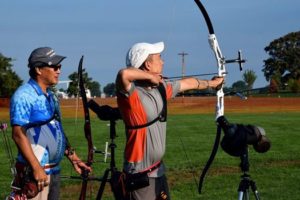With many large indoor tournaments fast approaching, this is a good time to get in the correct state of mind to shoot effectively. Just what is that state of mind? Well, it is different for every shooter, but some common elements exist.
A certain balance and calmness must exist. This calmness does not mean you are not excited, or nervous. It means you feel very certain about what it is you are going to do on the shooting line. Your shot, in whatever state it is currently, must be executed the same way you perform every day when practicing. As my dad often said to his collegues, ‘Let us proceed with alacrity.’ It is this clearness of purpose which will carry you through those nervous or exited times.
Another common element for shooters who perform well in tournaments is they do not worry about a particular score. Expectations are often the ruin of many otherwise excellent rounds. Allow performances to happen.
It is absolutely essential that you accept, evaluate and move forward from any particular result. Any lingering over a poor, or good shot, will result in a lack of focus on the upcoming shot. This process of evaluating, making a correction if necessary and moving forward keeps you focused on the job at hand, versus the past or what might happen in the future. Stay in the present and make your shot. What was cannot be changed and what will be is not relevant to what needs to be done now.
Every good shooter finds a way to bleed pressure. Some are reflective and silent, while others are chatty and engaged with others around them. It is different for everyone. What is important is for the archer to allow those competitive pressures to dissapate while not on the shooting line.
All good shooters learn from their tournament experiences. Never let a chance to learn and improve escape. It is only under tournament stress that we will truly understand what needs to be addressed in our archery.
Indeed, let us proceed with alacrity!

